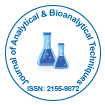Our Group organises 3000+ Global Conferenceseries Events every year across USA, Europe & Asia with support from 1000 more scientific Societies and Publishes 700+ Open Access Journals which contains over 50000 eminent personalities, reputed scientists as editorial board members.
Open Access Journals gaining more Readers and Citations
700 Journals and 15,000,000 Readers Each Journal is getting 25,000+ Readers
Google Scholar citation report
Citations : 6413
Journal of Analytical & Bioanalytical Techniques peer review process verified at publons
Indexed In
- CAS Source Index (CASSI)
- Index Copernicus
- Google Scholar
- Sherpa Romeo
- Academic Journals Database
- Open J Gate
- Genamics JournalSeek
- JournalTOCs
- ResearchBible
- China National Knowledge Infrastructure (CNKI)
- Ulrich's Periodicals Directory
- Electronic Journals Library
- RefSeek
- Directory of Research Journal Indexing (DRJI)
- Hamdard University
- EBSCO A-Z
- OCLC- WorldCat
- Scholarsteer
- SWB online catalog
- Virtual Library of Biology (vifabio)
- Publons
- Euro Pub
- ICMJE
Useful Links
Related Subjects
Share This Page
Duska Separovic
Biography
She has extended her valuable service as an Associate Professor (Research), Dept. of Pharmaceutical Sciences, Eugene Applebaum College of Pharmacy & Health Sciences, Wayne State University, in the year 2010. Her international experience includes various programs, contributions and participation in different countries for diverse fields of study. Her research interests reflect in her wide range of publications in various national and international journals
Research Interest
Her research interests primarily in the field of Photodynamic therapy (PDT), a type of cancer treatment that bypasses most of the problems associated with resistance to chemotherapy, produces in cells sphingolipids that are important in destroying cancer cells. We are interested in deepening our understanding of the regulation of sphingolipid metabolism after PDT, the role of sphingolipids in promoting cell death post-PDT, and in identifying drugs that are responsible for increasing the amounts of those sphingolipids that help killing cancer cells after PDT to enhance therapeutic value of PDT.
Publications
Mladen Korbelik, Judit Banáth, Wei Zhang, Fred Wong, Jacek Bielawski and Duska Separovic
Research Article: J Anal Bioanal Tech 2014, S1:009
Global Speakers in the subject
Global Experts in the subject
Relevant Topics
Peer Reviewed Journals
Make the best use of Scientific Research and information from our 700 + peer reviewed, Open Access Journals

 Spanish
Spanish  Chinese
Chinese  Russian
Russian  German
German  French
French  Japanese
Japanese  Portuguese
Portuguese  Hindi
Hindi 
